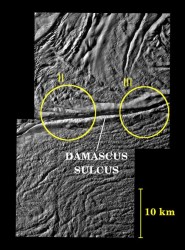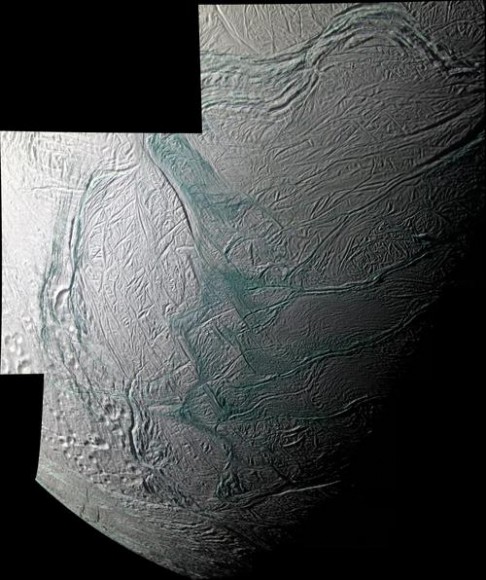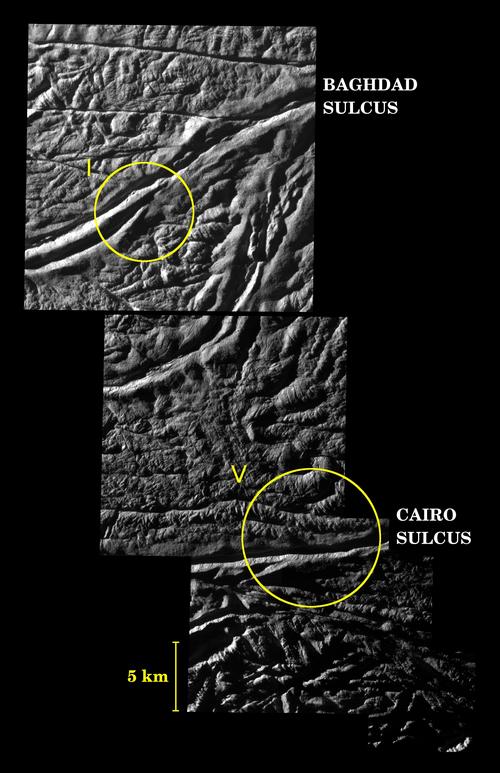[/caption]
Cassini scientists have been “bee-busy” poring over the images from the August 11 flyby of Saturn’s geyser-spewing moon Enceladus, says Carolyn Porco, the lead for the imaging team. And quickly, they have found exactly what they were looking for: Cassini has pinpointed precisely where the icy jets erupt from the moon’s geologically active moon surface. Enceladus. “This is the mother lode for us,” said Porco, “a place that may ultimately reveal just exactly what kind of environment — habitable or not — we have within this tortured little moon.”
New carefully targeted pictures reveal exquisite details in the prominent south polar “tiger stripe” fractures from which the jets emanate. The images show the fractures are about 300 meters (980 feet) deep, with V-shaped inner walls. The outer flanks of some of the fractures show extensive deposits of fine material. Finely fractured terrain littered with blocks of ice tens of meters in size and larger (the size of small houses) surround the fractures.

One highly anticipated result of this flyby was finding the location within the fractures from which the jets blast icy particles, water vapor and trace organics into space. Scientists are now studying the nature and intensity of this process on Enceladus, and its effects on surrounding terrain. This information, coupled with observations by Cassini’s other instruments, may answer the question of whether reservoirs of liquid water exist beneath the surface.
The high-resolution images were acquired as Cassini sped past the icy moon at 64,000 kilometers per hour (40,000 miles per hour). A special technique, dubbed “skeet shooting” by the imaging team, was developed to cancel out the high speed of the moon relative to Cassini and obtain the ultra-sharp views.
“Knowing exactly where to point, at just the right time, was critical to this event,” said Paul Helfenstein, Cassini imaging team associate at Cornell University, Ithaca, NY., who developed and used the skeet-shoot technique to design the image sequence. “The challenge is equivalent to trying to capture a sharp, unsmeared picture of a distant roadside billboard with a telephoto lens out the window of a speeding car.”

The tiger stripes, officially called sulci, have been named for characters and places from “The Arabian Nights.” The yellow circles on the images indicate the sources of the jets.
Helfenstein said that from Cassini’s point of view, “Enceladus was streaking across the sky so quickly that the spacecraft had no hope of tracking any feature on its surface. Our best option was to point the spacecraft far ahead of Enceladus, spin the spacecraft and camera as fast as possible in the direction of Enceladus’ predicted path, and let Enceladus overtake us at a time when we could match its motion across the sky, snapping images along the way.”
For scientists, having the combination of high-resolution snapshots and broader images showing the whole region is critical for understanding what may be powering the activity on Enceladus.
“There appears to have been extensive fallout of icy particles to the ground, along some of the fractures, even in areas that lie between two jet source locations, though any immediate effects of presently active jets are subtle,” said Porco.
Imaging scientists suggest that once warm vapor rises from underground to the cold surface through narrow channels, the icy particles may condense and seal off an active vent. New jets may then appear elsewhere along the same fracture.
“For the first time, we are beginning to understand how freshly erupted surface deposits differ from older deposits,” said Helfenstein, an icy moons expert. “Over geologic time, the eruptions have clearly moved up and down the lengths of the tiger stripes.”
News Source: NASA/JPL


Awesome. It is singularly impressive not only for the technological feat of the imagining itself, but for the treasure-trove of science that they’ve just hit on. It is definitely one of the most important milestones of the Cassini mission so far, and to think – there are loads more fly-bys planned for this amazing little moon in the newly extended mission plan!
Congrats Cassini team!
Hmm. On the original release the links point to a figure that makes the circles out as illustrating the uncertainty in location AFAIU; the actual outcome of a large series of measurements of jets (from 2007) are spread over a much larger area. (While I assume everyone expects them being associated with the sulci centers.)
The news is, AFAIU, that the skeet shot imagined the earlier located and imaged areas once again.
So as usual, a more confusing press release than not.
On a more positive note, the previous NASA blog entry claims that at least one of the thermal imaging instruments also pinpointed the hot spot areas. I assume that they possibly can resolve the actual temperatures better with increased resolution. Now, that would be interesting news!
Oops – I’m sure the skeet shot made a better image than an “imagined”. Coffee break time!
all the knit-pickers aside, keep up the good work.
One of the top space achievements ever. Right on up there with Voyager. Cassini is a triumph. And still more to come! Yes!
A question comes to mind; if the planet Mars over time lost it’s oceans to space how come Enceladus with a much smaller mass can still be out gassing so much moisture? Is this a fairly new activity, or would this fuel some speculation that perhaps Enceladus was “recently” captured from an outer orbit.